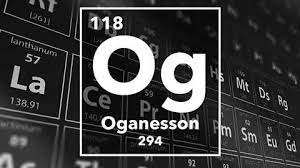History.
The story of oganesson begins in the quest to explore the uncharted
territory of superheavy elements. In 1999, scientists attempted to
synthesize element 118 by bombarding lead with krypton ions, but
success remained elusive.
The breakthrough came in 2002 at the Joint Institute for Nuclear
Research in Dubna, Russia. A collaborative effort between Russian
and American researchers successfully produced oganesson through a
different approach - fusing calcium ions with californium.
However, the confirmation process was meticulous.
After years of additional experiments and rigorous scrutiny, the
discovery of element 118 was finally recognized in 2015. In 2016,
it was officially named oganesson in honor of physicist Yuri
Oganessian, a pioneer in the field of superheavy element research.
This marked a significant milestone in our understanding of the
periodic table and the limits of atomic existence.
Usage.
Oganesson, the heaviest element known, currently lacks any practical
applications outside of fundamental scientific research. Due to its
extreme rarity and instability, with only a few atoms ever produced
and a half-life measured in milliseconds, oganesson is not feasible
for any technological or industrial use. However, studying its
properties helps scientists understand the behavior of matter at the
atomic level and refine our understanding of the periodic table,
potentially paving the way for future discoveries in material science
and nuclear physics.
-
Fundamental scientific Research: Oganesson serves as a
crucial stepping stone in understanding the limits of atomic
stability and how elements behave at the extremes of the periodic
table. Studying its properties helps refine nuclear models and
theories, pushing the boundaries of scientific knowledge.
-
Testing Nuclear Theories: The existence and properties of
Oganesson can be used to validate or refine existing nuclear
theories, particularly those concerning the stability of
superheavy elements. This can lead to a deeper understanding of
nuclear forces and the building blocks of matter.
-
Future material scienec applications: Though currently
impractical, theoretical predictions suggest Oganesson might
exhibit unique chemical properties due to relativistic effects.
Understanding these properties could potentially pave the way for
the development of novel materials with unforeseen functionalities
in the distant future.
-
Inspiration for turther exploration : Oganesson's discovery
serves as a testament to human ingenuity and our ability to push
the boundaries of scientific exploration. It inspires further
research into the unexplored territories of the periodic table,
potentially leading to the discovery of even heavier elements and
expanding our understanding of the universe.
Some of the benefits of using Tennessine are:
-
Oganesson serves as a crucial piece in the puzzle of understanding
the limits of atomic stability and how elements behave at the
fringes of the periodic table. Studying its properties helps
refine nuclear models and theories, pushing the boundaries of our
scientific knowledge about matter.
-
The existence and properties of Oganesson can be used to test and
refine existing nuclear theories, particularly those concerning
the stability of superheavy elements. This can lead to a deeper
understanding of nuclear forces and the fundamental building
blocks of matter.
-
While currently impractical, theoretical predictions suggest
Oganesson might exhibit unique chemical properties due to
relativistic effects. Understanding these properties could
potentially pave the way for the development of novel materials
with unforeseen functionalities in the distant future.
-
Oganesson's discovery serves as a testament to human ingenuity and
our ability to push the boundaries of scientific exploration. It
inspires further research into the unexplored territories of the
periodic table, potentially leading to the discovery of even
heavier elements and expanding our understanding of the universe.
